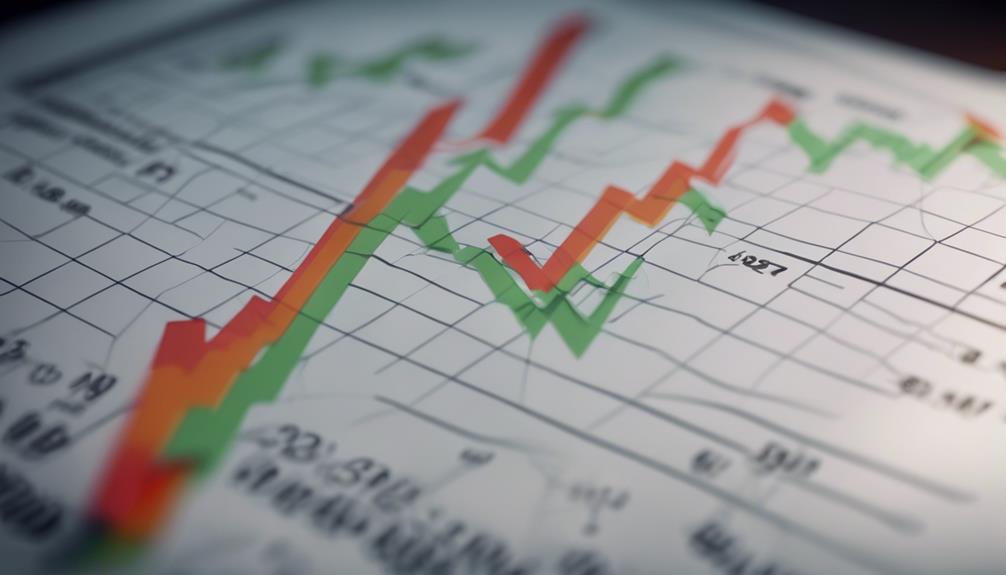Fluctuations in stock prices have a profound impact on economic conditions, highlighting the interconnectedness between financial markets and overall economic health. Stock values and economic growth share a symbiotic relationship, each influencing the other's trajectory. Understanding historical trends, factors like company performance and investor sentiment, and the impact of economic policies on stock prices are vital to grasping this relationship's depth. Stock market volatility can either boost or hamper economic stability, underscoring the need for strategic investment alignment with economic growth indicators. Recognizing these dynamics is essential for making informed decisions in the ever-evolving landscape of finance and economics.
Historical Trends in Stock Prices and Economic Growth

Examining the correlation between historical trends in stock prices and economic growth reveals intriguing patterns that shed light on the interconnected nature of financial markets and overall economic performance. Stock market bubbles, characterized by rapid escalation of asset prices followed by a sharp contraction, have historically been associated with periods of economic exuberance and subsequent downturns. The dot-com bubble of the late 1990s and the housing bubble of the mid-2000s are prime examples where inflated stock prices preceded economic crises.
Conversely, stock market crashes, such as the Great Depression in the 1930s and the global financial crisis of 2008, often coincide with economic recessions. These downturns are marked by a significant decline in stock prices, triggering a ripple effect across various sectors of the economy. Understanding these historical trends can provide valuable insights into the cyclical nature of financial markets and their impact on broader economic conditions. By analyzing past events, investors and policymakers can better prepare for future challenges and opportunities in the dynamic landscape of stock prices and economic growth.
Factors Influencing Stock Prices
An understanding of the various factors that influence stock prices is essential for investors seeking to make informed decisions in the financial markets. Market analysis plays a pivotal role in determining stock prices. Factors such as company performance, industry trends, macroeconomic indicators, and investor sentiment all contribute to the fluctuations in stock prices.
Price fluctuations are often a reflection of how investors perceive the value of a company's stock. Positive news, such as strong earnings reports or new product launches, can lead to an increase in stock prices, while negative developments, like regulatory issues or economic downturns, can cause prices to fall.
Moreover, market analysis involves examining supply and demand dynamics, interest rates, inflation, and geopolitical events to gauge the potential impact on stock prices. Understanding these factors can help investors anticipate market movements and make informed decisions about buying or selling stocks. By staying informed and conducting thorough research, investors can navigate the complexities of the stock market with greater confidence.
Impact of Economic Policies on Stock Prices

Economic policies play a pivotal role in influencing stock prices, as they can directly impact market sentiment and investor confidence. The reaction of the stock market to policy announcements is often swift and significant, reflecting the market's interpretation of the potential outcomes of these policies on various sectors. Understanding the intricate relationship between economic policies and stock prices is essential for investors and policymakers alike to navigate the complexities of the financial markets.
Policy Influence on Stocks
Amidst the dynamic landscape of financial markets, the implementation of various economic policies greatly influences the trajectory of stock prices.
- Government Intervention: Direct interventions by governments in the form of stimulus packages or regulatory changes can have a profound impact on investor sentiment and stock valuations.
- Market Manipulation: Instances of market manipulation, where certain entities artificially inflate or deflate stock prices for personal gain, can create volatility and undermine market confidence.
- Policy Clarity: Clear and consistent economic policies provide stability and predictability for investors, fostering a more conducive environment for stock price growth.
Understanding the interplay between economic policies and stock prices is essential for investors navigating the complexities of the financial markets.
Market Reactions to Policies
The impact of economic policies on stock prices can be gauged through the market reactions they elicit, revealing the intricate relationship between policy decisions and investor behavior. Government decisions, such as changes in interest rates or fiscal stimulus packages, have immediate policy implications that reverberate throughout financial markets. When policies are announced, investors swiftly assess the potential impact on companies and industries, leading to market reactions that can result in stock price fluctuations. Investor responses to policies are often driven by expectations of how these decisions will shape the business environment and ultimately influence corporate earnings. Understanding these market dynamics is essential for investors and policymakers alike, as it sheds light on the interconnectedness between economic policies and stock market performance.
Economic Policy Impact
With a discerning eye on policy shifts, investors keenly evaluate the impact of governmental decisions on stock prices, maneuvering through the intricate web of market reactions and economic indicators. When it comes to economic policy impact, two key factors play a significant role:
- Fiscal Stimulus: Policies related to government spending and taxation can directly influence stock prices by affecting consumer demand, business profitability, and overall economic growth.
- Monetary Policy: Actions taken by central banks to control money supply, interest rates, and credit conditions can have a profound impact on stock prices, as they influence borrowing costs, investment decisions, and overall market liquidity.
- Regulatory Changes: Shifts in regulations can alter the competitive landscape for businesses, impacting stock prices as investors reassess risks and growth prospects.
Role of Investor Sentiment in Stock Prices

Investor sentiment plays an essential role in influencing stock prices, as it can drive market psychology and impact trading decisions. Understanding sentiment analysis techniques can provide valuable insights into market trends and potential price movements. By monitoring and interpreting investor sentiment accurately, traders and analysts can make more informed decisions regarding their investment strategies.
Investor Sentiment Impact
Evidence suggests that fluctuations in investor sentiment have a significant impact on stock prices. Behavioral finance analysis and market psychology play an essential role in understanding this relationship. Investor behavior and sentiment analysis are key factors that drive market movements. When investor sentiment is positive, stock prices tend to rise as more individuals are willing to invest, driving demand. Conversely, during periods of negative sentiment, stock prices may experience a decline as investors become more risk-averse. Understanding the nuances of investor sentiment can provide valuable insights into market dynamics and help anticipate potential price movements. Analyzing sentiment indicators alongside market fundamentals can offer a thorough view of stock price behavior.
Market Psychology Influence
Market psychology plays an important role in influencing stock prices through the impact of investor sentiment. Market sentiment, a key component of behavioral finance, reflects the collective feelings and attitudes of investors towards a particular security or the market as a whole. Investor behavior, influenced by market trends and external factors, can drive stock prices to either overvalued or undervalued levels based on emotions like fear, greed, or optimism. Understanding these psychological aspects is essential for investors and analysts to make informed decisions. Market psychology can create momentum in stock prices, leading to trends that may not always align with the fundamentals of a company. This interplay between investor sentiment and stock prices underscores the importance of considering behavioral factors in financial analysis.
Sentiment Analysis Techniques
Utilizing advanced sentiment analysis techniques can provide valuable insights into the impact of investor sentiment on stock prices. Through text data analysis and sentiment modeling, analysts can extract valuable information from various sources to gauge market sentiment accurately. When focusing on social media sentiment, analysts can gather real-time data on public opinions and reactions, which can be indicative of market movements. This real-time data can be leveraged for more accurate market predictions, enabling investors to make more informed decisions. By incorporating sentiment analysis techniques into their analytical toolkit, investors can gain a deeper understanding of how emotions and perceptions influence stock prices, ultimately enhancing their ability to navigate the dynamic landscape of the stock market.
Long-Term Effects of Stock Prices on Economic Growth

Over time, the symbiotic relationship between stock prices and economic growth reveals its profound influence on the trajectory of financial markets and overall prosperity. When examining the long-term effects of stock prices on economic growth, it becomes evident that fluctuations in stock market performance can have a substantial impact on a country's GDP. For instance, periods of robust stock market performance often coincide with increased consumer and business confidence, leading to higher levels of investment and economic activity. On the other hand, stock market bubbles, characterized by unsustainable price increases, can result in economic downturns despite initial phases of apparent economic expansion.
| Long-Term Effects of Stock Prices on Economic Growth | |
|---|---|
| Stock Market Performance | GDP Correlation |
| Positive stock market trends are often linked to economic growth as they signal investor confidence and potential for increased spending and investment. | Stock prices are positively correlated with GDP growth, indicating a strong interdependence between stock market performance and overall economic health. |
| Stock Market Bubbles | Economic Expansion |
| Stock market bubbles, fueled by speculative trading and inflated asset prices, can lead to financial instability and economic recessions when they eventually burst. | While stock market bubbles may initially contribute to economic expansion, their eventual collapse can have a significant negative impact on economic growth and stability. |
Stock Market Volatility and Economic Stability
Stock market volatility poses a critical challenge to maintaining economic stability, requiring strategic management and adaptation to mitigate potential risks and uncertainties. Market fluctuations can have a substantial impact on economic indicators, leading to periods of uncertainty and instability. Understanding investor behavior is essential in navigating through these fluctuations and ensuring market stability. Here are three key points to take into account:
- Impact on Consumer Confidence: Sudden market movements can erode consumer confidence, leading to reduced spending and investment, which can in turn slow down economic growth.
- Financial System Resilience: Volatility can strain the financial system, affecting banks and other financial institutions, potentially leading to systemic risks that threaten economic stability.
- Policy Responses: Governments and central banks often need to respond swiftly to market volatility through appropriate policy measures to restore confidence and stabilize the economy.
Dealing with stock market volatility requires a deep understanding of market dynamics, investor psychology, and proactive policy responses to secure overall economic stability.
Strategies for Aligning Investments With Economic Growth

Effective investment strategies play an essential role in aligning with and supporting economic growth trajectories. One key strategy is investment diversification, which involves spreading investments across different asset classes to reduce risk. By diversifying, investors can mitigate the impact of market fluctuations on their overall portfolio performance. Another important aspect is keeping a close eye on economic indicators. Understanding indicators such as GDP growth, unemployment rates, inflation, and consumer spending can help investors make informed decisions about where to allocate their resources for best returns.
Moreover, aligning investments with economic growth requires a forward-thinking approach. Investors should consider long-term trends and potential shifts in the economic landscape when crafting their investment strategies. By staying proactive and adaptable, investors can position themselves to capitalize on emerging opportunities and navigate challenges effectively. Ultimately, a well-thought-out investment plan that takes into account diversification and economic indicators can help individuals and organizations align their investments with the broader goal of supporting economic growth.
